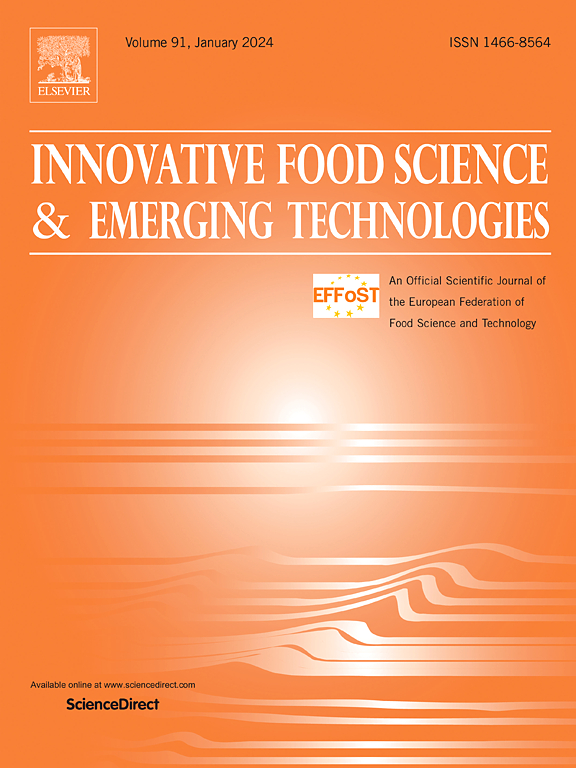Modification of the microstructure and cell wall polysaccharides alters drying behavior and biological activities of Gastrodia elata by high hydrostatic pressure pretreatment
IF 6.8
1区 农林科学
Q1 FOOD SCIENCE & TECHNOLOGY
Innovative Food Science & Emerging Technologies
Pub Date : 2025-06-21
DOI:10.1016/j.ifset.2025.104093
引用次数: 0
Abstract
This study investigated the effects of high hydrostatic pressure (HHP: 100–300 MPa) on the microstructure, cell wall polysaccharides, drying kinetics, and bioactivity retention of Gastrodia elata (G. elata). Microstructure analysis revealed HHP-induced cellular damage of G. elata, including wall rupture and intercellular space expansion, proportional to pressure intensity. HHP altered pectin fractions, converting covalently/ionically bound polysaccharides (CSP, NSP) into water-soluble forms (WSP), weakening cell adhesion. Fourier transform infrared spectroscopy and principal component analysis confirmed structural modifications in pectin matrices, correlating with pressure-dependent depolymerization. Drying time decreased by 32.46 % at 250 MPa, while rehydration improved due to microstructural changes. HHP enhanced retention of phenolic compounds, flavonoids, and polysaccharides of G. elata during in vitro digestion, with elevated gastrodin and parishins bioavailability. Furthermore, HHP-treated samples exhibited superior inhibition of acetylcholinesterase (48.65 %), α-glucosidase (54.28 %), and xanthine oxidase (42.03 %), linked to enhanced bioactive accessibility. These findings demonstrate HHP's potential to optimize G. elata processing while preserving functional properties.
高压水静压预处理对天麻的微观结构和细胞壁多糖的修饰改变了天麻的干燥行为和生物活性
研究了高静水压力(HHP: 100-300 MPa)对天麻微观结构、细胞壁多糖、干燥动力学和生物活性保持的影响。微观结构分析表明,高温高压诱导的大叶藻细胞损伤表现为细胞壁破裂和胞间空间扩张,与压力强度成正比。HHP改变了果胶组分,将共价/离子结合的多糖(CSP, NSP)转化为水溶性形式(WSP),削弱了细胞粘附。傅里叶变换红外光谱和主成分分析证实了果胶基质的结构修饰,与压力相关的解聚有关。250mpa下干燥时间缩短32.46%,微观结构的改变使复水化时间延长。在体外消化过程中,HHP增强了天麻酚类化合物、黄酮类化合物和多糖的保留率,同时提高了天麻素和天麻素的生物利用度。此外,经hhp处理的样品对乙酰胆碱酯酶(48.65%)、α-葡萄糖苷酶(54.28%)和黄嘌呤氧化酶(42.03%)的抑制作用更强,从而提高了生物活性可及性。这些发现证明了HHP在保持其功能特性的同时,有潜力优化叶黄加工。
本文章由计算机程序翻译,如有差异,请以英文原文为准。
求助全文
约1分钟内获得全文
求助全文
来源期刊
CiteScore
12.00
自引率
6.10%
发文量
259
审稿时长
25 days
期刊介绍:
Innovative Food Science and Emerging Technologies (IFSET) aims to provide the highest quality original contributions and few, mainly upon invitation, reviews on and highly innovative developments in food science and emerging food process technologies. The significance of the results either for the science community or for industrial R&D groups must be specified. Papers submitted must be of highest scientific quality and only those advancing current scientific knowledge and understanding or with technical relevance will be considered.

 求助内容:
求助内容: 应助结果提醒方式:
应助结果提醒方式:


